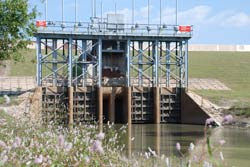Environmental Assessment and Public Communication for the Addicks and Barker Dam Safety Program, US Army Corps of Engineers Galveston District, Texas
 Addicks and Barker Dams are two 11-mile-long earthen dams creating 16,000 acres of reservoir in the heavily populated western region of Harris County. The outlet structures at Addicks and Barker Dams, which feed into Buffalo Bayou, have been deemed to be at high risk of failure due to structural integrity and their associated flooding risk to the region. With this information, the US Army Corps of Engineers (USACE) led an intensive study of the structures and a concurrent public awareness and community education campaign to communicate this risk to the adjacent communities.
Addicks and Barker Dams are two 11-mile-long earthen dams creating 16,000 acres of reservoir in the heavily populated western region of Harris County. The outlet structures at Addicks and Barker Dams, which feed into Buffalo Bayou, have been deemed to be at high risk of failure due to structural integrity and their associated flooding risk to the region. With this information, the US Army Corps of Engineers (USACE) led an intensive study of the structures and a concurrent public awareness and community education campaign to communicate this risk to the adjacent communities.
The risks associated with these dams include flooding of regions both upstream and downstream of these structures, including downtown Houston and the many industrial complexes along the Houston Ship Channel.
Crouch Environmental Services’ scope included NEPA documentation, incremental cost analysis, and habitat analysis for reconstruction of Addicks and Barker Dams. In addition to these efforts, Crouch Environmental Services conducted field studies and records reviews to document the existing environment surrounding the dams (portions of the dry reservoirs made up of over 50,000 acres) including wetlands, waters, threatened and endangered species, aesthetics, floodplains, soils, farmland, socio-economics, air quality, and noise impacts. Crouch provided the USACE with a comprehensive Environmental Assessment documenting the purpose and need for the project, alternatives considered, the existing environment, and the direct, indirect, and cumulative impacts that would result from the project. A biological assessment was prepared for the project that documented potential impacts to threatened and endangered species that would result from the project. In order to ensure that the proposed wetland mitigation would fully compensate for the proposed impacts, Crouch conducted complex ecological modeling using the US Fish and Wildlife Service’s Habitat Evaluation Procedure. An incremental cost analysis was also conducted to guarantee that the proposed mitigation was cost effective and a best-buy scenario.
Crouch Communications, a branch of Crouch Environmental Services, developed a comprehensive communications plan, and a multi-step public awareness campaign was implemented through 2012. To kick off the communication initiative, Crouch Communications held a total of 11 outreach meetings in February 2010 – 4 meetings hosting the general public and 7 other meetings targeted towards various media, public officials, and interested stakeholder groups. Crouch Communications prepared a branding system, mass invitations of attendance, multiple collateral pieces, an online web presence (www.addicksandbarker.info), a social media presence, and a 20-minute video explaining the subjects of investigation and the associated risk. A follow-up large‑scale public meeting was held in subsequent months to provide an update to the interested public about the outcome and findings of the Addicks and Barker Dam Safety Modification Studies.
Risk communication is a delicate and necessary task, and the Crouch Communications team was honored to assist USACE in launching and implementing this awareness campaign. The well-attended public meetings allowed for broad dissemination of key project messages that were easily understood by the public. Ensuing media coverage was balanced and accurate, focusing on the proactive measures being taken by the USACE and personal safety responsibilities of the public. The public involvement approach developed by Crouch Communications was named a national “Best Practice” by the USACE National Headquarters.
